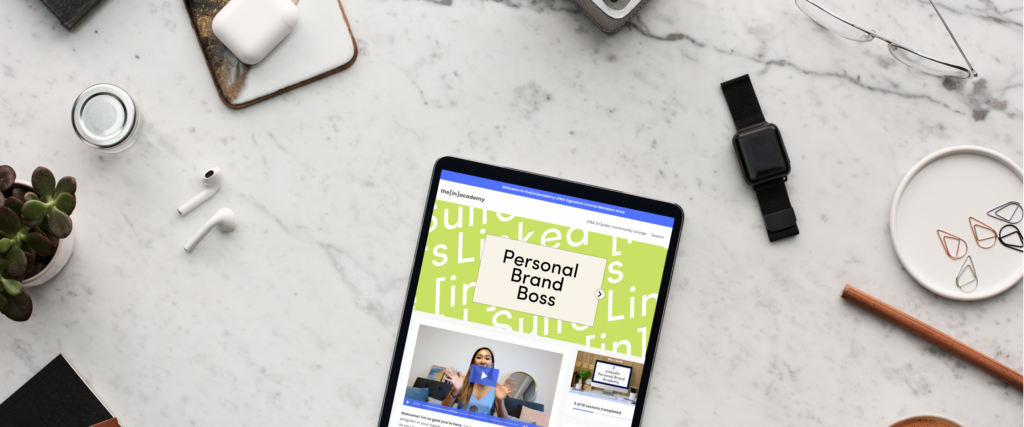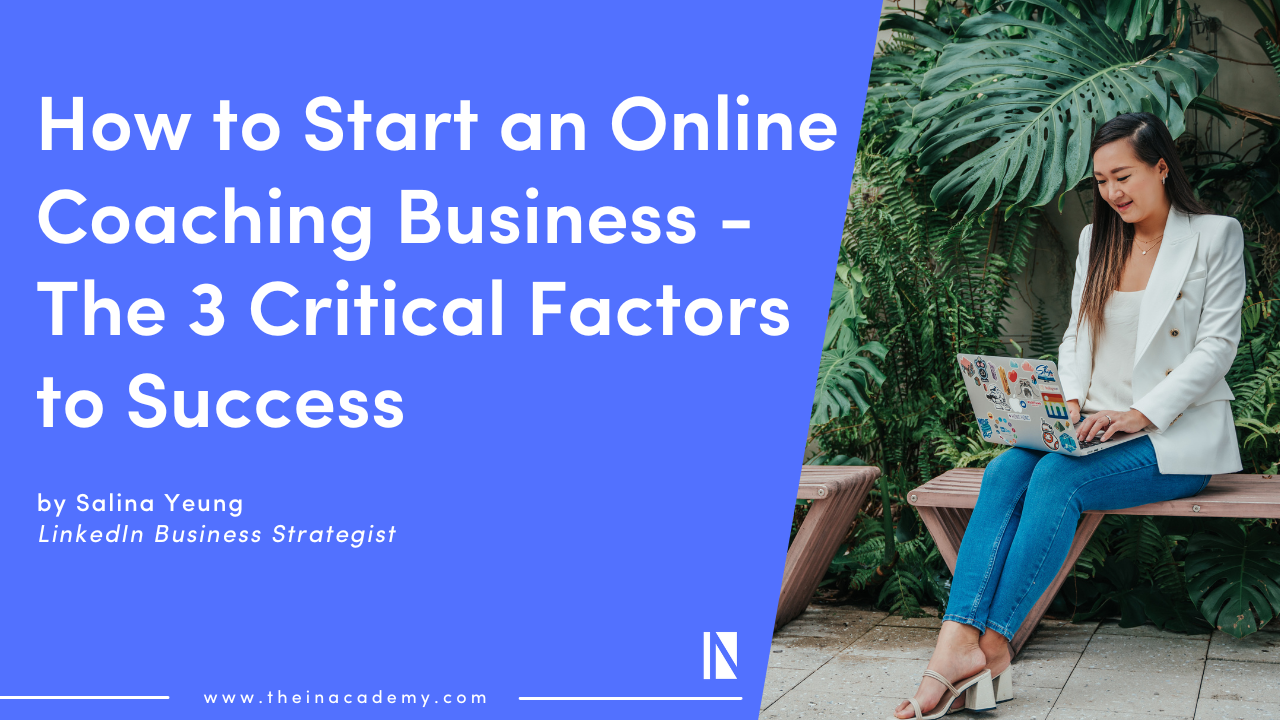I love helping people and coaching them online which has a positive impact on their careers and livelihood. I get goosebumps just knowing how my knowledge and experience with LinkedIn marketing help my clients fully utilize the power of their professional network to sign their first (and next) clients from LinkedIn.
I wanted to create a business that contributes to the success of other online business owners, who in return, have a strong desire to help others (ie: content creators, and educational coaches). A full circle of good help, helping good people!
My goal was to help my clients become more visible in front of business decision-makers on LinkedIn and to have a business model that allows them to build wealth. Remember, you can’t further your mission if you’re not making the money necessary to grow and fund it.
This is why I’m spilling the beans on how to start an online coaching business with the 3 critical components to incorporate as the building blocks for success.
3 Critical Components to Jumpstart Your Online Coaching Business
Imagine this proven framework operates like a 3-legged stool, each individual phase is powerful but can’t fully be optimized without the support of each pillar to get the consistent sales you want.
- Personal Branding
- Intentional Content
- Relationship Selling
Each component is powerful but is interlocked with one another to create an effective foundation to get the sales results you want for your online coaching business.
Let’s start with personal branding, the first critical step to building your online coaching business.
1. Develop a Killer Personal Brand on LinkedIn
Most budding online coaches will immediately want to jump into creating a website for their online coaching business but little do they realize they (most likely) already have an online presence with their LinkedIn profile. LinkedIn is the best platform where your personal brand lives and thrives (if done properly) to launch your coaching business. More than 12% of LinkedIn members (830M) are business decision-makers on LinkedIn.
[ What is a Personal Brand? ]
Intentional development of your professional story online of what you want to be known for that will influence how people will recognize and remember you.
As I love to say: If you want to invest in something with minimum risk and guaranteed the biggest return, invest in yourself. If you take the time and put in the work, this experience can be completely life-changing for you.
— by Salina Yeung
Taking the time to evaluate your personal brand on LinkedIn can be used as a litmus test to see how you’re perceived or what you’re known for as a professional. Understanding what you’re being recognized or remembered for can help leverage and optimize the most valuable attributes of your brand or trigger a plan of action to pivot your messaging to reflect your coaching services and skills.
How to Evaluate Your Personal Brand on LinkedIn
There are 3 ways to learn more about the effectiveness of your personal brand.
- Direct messages, when people message you on LinkedIn identify the top reasons why people have reached out to you (overlooking the generic “I’d like to add you to my network” message- common misuse of messaging on LinkedIn).
- Message people, if you don’t have many or anyone sharing why they want to connect with you on LinkedIn in their message – ask them in the reply back to their connect request what sparked them to make a request.
- Social Selling Index
Gathering and identifying the top reasons why people are reaching out to you will give you a better idea of what you’re recognized for, a telling indicator of how your brand is being perceived.
And if you’re having to message people (evaluating point #2) to learn more about how your personal brand is being perceived, that should be a signal within itself that your brand story may not be compelling enough for people to write a message of why they are reaching out to you.
Your brand messaging should be so clear and powerful that people are becoming fans and admirers of your content online that they felt compelled enough to write a personal message.
If your inbox doesn’t have any messages of that kind, now is the time to create content that will help define your brand messaging with intentional content creation. The next critical component for your online coaching business.
Want 5 inspiring examples of personal brands on LinkedIn that are killing it? Check out the article where I share the example.
2. Creating Content For Your Online Coaching Prospects
Creating content on LinkedIn with the intention of developing a strong brand story about your expertise, knowledge, and how and why you help others will help build an audience of potential prospects and demand for your services.
What Type of Content Should I Create for my Online Coaching Business?
Not all content is created equal. Video posts have 5x more engagement opportunities than a written post, whereas a LinkedIn Live has 24x more engagement. Whereas a self-published LinkedIn article can help you build upon your thought leadership and written posts are quick snippets that can build your personal brand holistically. Here is an infographic that breaks down the most common types of LinkedIn content:
| Type of LinkedIn Content | Purpose | Opportunity of Reach & Connection |
| Written Post with Image | Image with a written post gives a visual context to the story you’re sharing. | 2x higher engagement than without an image. More opportunities for people to comment or like. |
| Document or carousel | Visual storytelling by having the user click to the next step or slide to learn the entire message or story. | Posts with images have a 98% better comment rate. The attractive images and text can influence the viewer to save the post – especially with an effective CTA. |
| Video post | To showcase your personality and likeability through video. An instant ”get-to-know me.” | 5x higher engagement for people to comment or like and viewers can replay as many times as they like. |
| LinkedIn Article | Long-form content that allows you to elaborate on your knowledge and expertise on a specific topic or subject. | Embedded CTA (call to action) to encourage readers to contact you directly or to collect emails. Articles have an opportunity for SEO. |
| LinkedIn Live | Unedited live display of your personality thought leadership, and coaching in action. | Interact and engage with your audience in real-time and post-show. |
[in]siders’ Success Stories
David Wang – Text Post about AAPI via LinkedIn (1.5M Impressions, 3132 engagements, 125 Conversations and 13 re-shares)
Seb Jauslin – Share his Story via LinkedIn (200K impressions, 208 engagements and 46 conversations)
Daniela Herrera – Text Post (500K impressions, 335 engagement and 31 conversations and 10 re-shares)
3. Relationship Selling for your Coaching Business
What exactly is relationship selling? It’s when your leads derive from the thoughtful execution of your personal branding that created the “know, like, and trust’ factor which ultimately transforms viewers into interested prospects.
Relationship selling saves you the time to convince someone to sign up with you and cuts out the “hard sale” talk and messaging from your marketing efforts. The content you intentionally create helps paint a vivid picture of who you are as a coach and the services you provide. With thoughtful and creative content creation, it does all the selling for you.
In fact, the Rule of & comes into play – a prospect needs to hear and view your marketing message at least 7 times before they’ll take action or consider purchasing your product. Imagine a new lead is on a call with you, they’ve already established 2-3 touch points with you. It prioritizes sales leads from cold, warm, and hot relationships, so it saves you time.
Once you’ve reached the point of meeting one-to-one, the prospect already knows your work and who you are, allowing you to only focus on closing the deal. I prefer this type of selling any day of the week!
Final Takeaway- How to Start an Online Coaching Business
So before you turn your focus, time, and money into a website for your coaching business, take the time to evaluate your online presence on LinkedIn. It’s the only platform where you can effectively build a personal brand in front of a community that loves to learn, looking to advance professionally, and need help doing so. Your helpful and valuable content can meet them where they’re at and once they’re ready to dig a little further, you will be there ready to help and coach them to the next level.
Want to know the exact steps and must-have tips for building your personal brand on LinkedIn?
📍 Join me [in]side Personal Brand Boss™ – create a follow-worthy personal brand that attracts your ideal clients + Transform your (yawn!) LinkedIn Profile into a highly converting sales page and so much more…

theinacademy.com
Take a look around.
[in]side the algorithm
Inside the Algorithm is your weekly download of all things business and magnetic content marketing, from exclusive LinkedIn insider Tips by Salina & Faisal to incredible guest contributors.
JUICY DEETS EVERY WEDNESDAY MORNING!
